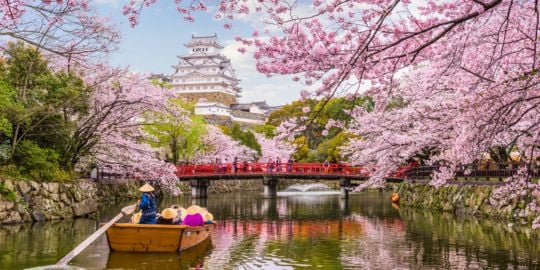About the Japan Rail Pass:
The Japan Rail Pass or JR Pass as it is commonly known is a travel ticket that can be used on Japan's Shinkansen Bullet trains, certain local trains, some bus lines and the JR-WEST Hiroshima-Miyajima ferry. It is only available to overseas visitors that enter Japan as a “Temporary Visitor”. This includes sightseeing, visiting relatives, inspection tours, conferences and meetings or other activities during a short stay in Japan. It is also available to Japanese nationals living overseas although certain conditions apply.
The JR Pass allows unlimited travel throughout Japan. You can apply for a 7 day, 14 day or 21 day pass. Once you have your pass you may not exchange or extend it. Travel by train, especially on the Shinkansen is expensive so having a JR Pass could save you a lot in travel expenses if you plan to visit different cities in Japan.
Trains covered by the JR Pass include:
- All the JR Shinkansen Bullet trains
- The Narita-Tokyo Express
- The Tokyo Monorail
- The Yamanote Line, Chuo and Keihin- Tohoku Lines in Tokyo
- The Osaka Loop Line (connecting lines to Kyoto, Kobe, Nara and Nagoya)
- The IR Ishiklawa Railway between Tsubata and Kanazawa
- The Aimokaze Toyama Railway between Takaoka and Toyama
- The Aoimori Railway between Hachinobe and Aomori
Buses included in the JR Pass:
- Local lines of JR Bus
- JR Buses: JR Bus Tohoku, JR Tokai Bus, JR Bus Kanto, JR Kyushu Bus, West Japan - JR Bus, Chugoku JR Bus, JR Shikoku Bus, JR Hokkaido Bus
- The JR Pass is not valid on the express bus routes operated by JR
There are two types of JR Pass:
1. The Ordinary JR Pass
The Ordinary JR Pass means that you will need to sit in one of the free seating carriages, usually carriages 1 – 7 and carriage 12 or 13.
2. The Green JR Pass
The Green JR Pass entitles you to travel on certain exclusive Shinkansen trains in addition to all other Shinkansen trains. You will have large comfortable seats, free snacks, and your seating will be reserved.
From personal experience, having used both the Green Pass and the Ordinary Pass, I feel there is little difference in comfort unless you are travelling on one of the more exclusive Shinkansen trains and that it is not worth paying the extra cost for the Green Pass. Furthermore, you will nearly always find available seats in the free seating section unless you travel during the rush hour.
How to Apply for the JR Pass:
In order to obtain the JR Pass you will firstly need to buy an Exchange Order for the Japan Rail Pass outside of Japan at one of the following overseas sales offices or agents before coming to Japan:
JTB Corp, Nippon Travel Agency, Kintetsu International, Tobu Top Tours, All Nippon Airways (you will also need to book a JAL flight) or JALPAK and their associated agencies (you will also need to book an ANA flight). A list of sales offices around the world can be found at:
- Sales Offices in East Asia
- Sales Offices in Southeast Asia
- Sales Offices in South Asia
- Sales Offices in North America
- Sales Offices in Europe
- Central & South America
- Sales Offices in Oceania
- Sales Offices in Middle East
- Sales Offices in Africa
Once you have purchased your Exchange Order you must submit it to a Japan Rail Pass exchange office at your point of entry into Japan. You can easily find a JR Pass Office at all major airports once you have passed through immigration and customs and close to the train terminal in the airport. At the office you can exchange your Exchange Order for your Japan Rail Pass and only need to fill out a simple application form and present your passport with your Temporary Visitor stamp. The name on the Exchange Order must be the same as the name on your passport. Please note that when you first buy your Exchange Order in your home country, you must arrive in Japan and present it to the Japan Rail Pass exchange office within three months of the purchase date.
Price of the JR Pass:
Prices may vary a little depending on where you buy the Exchange Order. These are the normal prices as of March 2016:
JR Pass Ordinary:
7 Days ¥29,110 (adults) & ¥14,550 (children 6 – 11)
14 Days ¥46,390 (adults) & ¥23,190 (children 6 – 11)
21 Days ¥59,350 (adults) & ¥26,670 (children 6 – 11)
JR Pass Green:
7 Days ¥38,880 (adults) & ¥19,440 (children 6 – 11)
14 Days ¥62,950 (adults) & ¥31,470 (children 6 – 11)
21 Days ¥81,870 (adults) & ¥40,930 (children 6 – 11)
(Children below the age of 6 can travel free of charge)
Note: Please be aware that there are several companies and travel agents offering the Exchange Order for the Japan Rail Pass online. Should you choose to purchase the Exchange Order from one of them you will need to follow the same procedures as above to obtain your Japan Rail Pass.
More complete information about the Japan Rail Pass can be found at:
http://www.japanrailpass.net/en/index.html
How to apply for the Japan Rail Pass
This is the Shinkansen which departs from Tokyo Main station and terminates at Osaka.
Prior to departure, a team of cleaners dressed in pink uniforms thoroughly clean every carriage of the Shinkansen. A few minutes before the train is scheduled to depart, the doors open for passengers to board. Passengers are expected to queue on the designated areas that are marked on the ground (in grey) at every entrance to the train.
The Shinkansen arrives at Mishima Station
Subscribe to this topic

Open a bank account that suits you
Discover the best international banks to manage your money securely.
"








